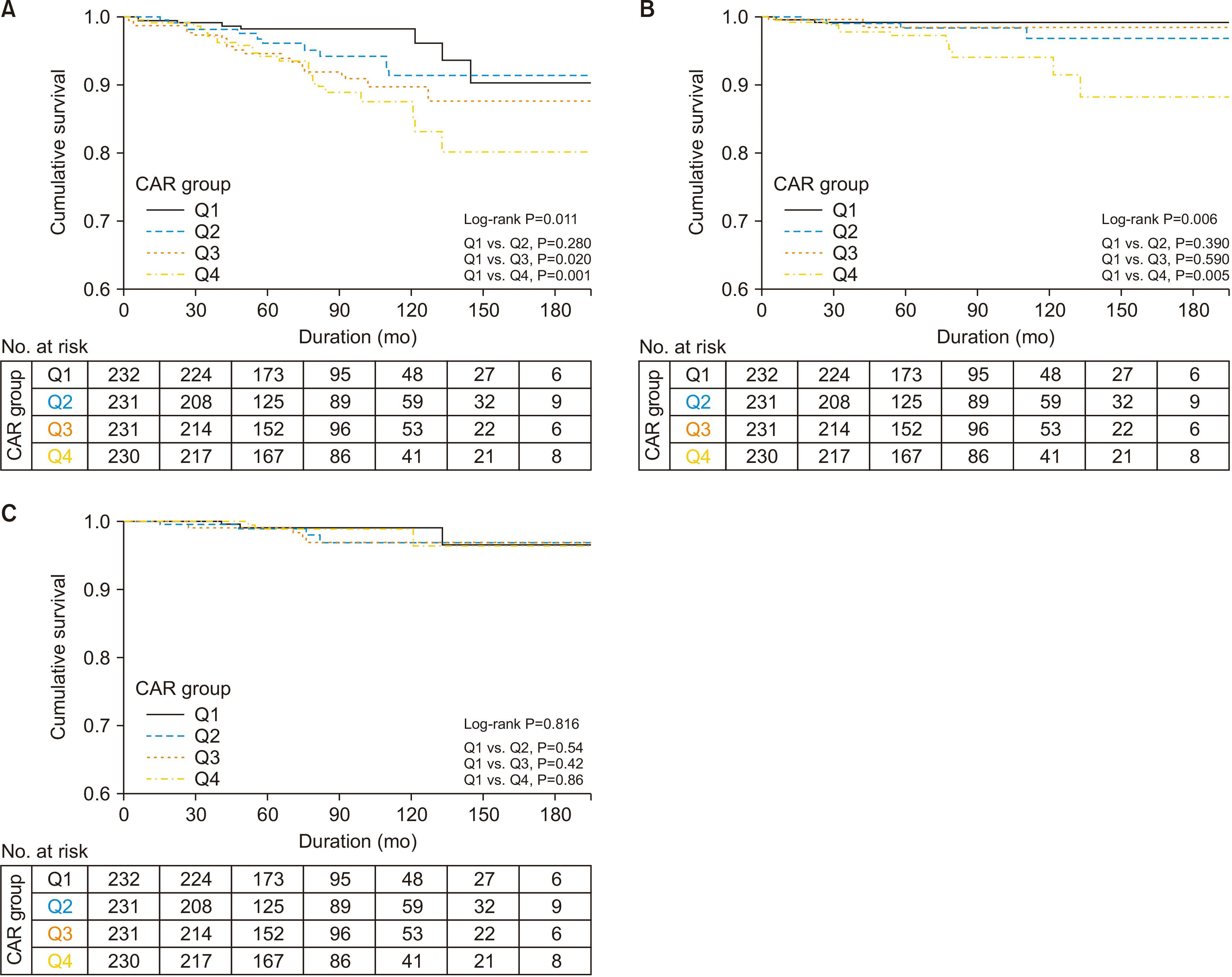1. Park S, Kim M, Kim JE, Kim K, Park M, Kim YC, et al. 2020; Characteristics of kidney transplantation recipients over time in South Korea. Korean J Intern Med. 35:1457–67. DOI:
10.3904/kjim.2019.292. PMID:
32218102. PMCID:
PMC7652657.
2. Song JY, Lee KW, Kim K, Kim KD, Yang J, Kwon JE, et al. 2021; Recipient efficacy and safety of kidney transplantation from older living donor: consideration for using older kidney as a solution to the shortage of organs. Korean J Transplant. 35:238–46. DOI:
10.4285/kjt.21.0020. PMID:
35769855. PMCID:
PMC9235463.
3. Arend SM, Mallat MJ, Westendorp RJ, van der Woude FJ, van Es LA. 1997; Patient survival after renal transplantation; more than 25 years follow-up. Nephrol Dial Transplant. 12:1672–9. DOI:
10.1093/ndt/12.8.1672. PMID:
9269647.
4. Kaballo MA, Canney M, O'Kelly P, Williams Y, O'Seaghdha CM, Conlon PJ. 2018; A comparative analysis of survival of patients on dialysis and after kidney transplantation. Clin Kidney J. 11:389–93. DOI:
10.1093/ckj/sfx117. PMID:
29942504. PMCID:
PMC6007575.
5. Carminatti M, Tedesco-Silva H, Silva Fernandes NM, Sanders-Pinheiro H. 2019; Chronic kidney disease progression in kidney transplant recipients: a focus on traditional risk factors. Nephrology (Carlton). 24:141–7. DOI:
10.1111/nep.13483. PMID:
30159972.
6. Cheng CY, Feng YT, Wang HY. 2020; Incidence and relative risk factors in posttransplant diabetes mellitus patients: a retrospective cohort study. Korean J Transplant. 34:213–37. DOI:
10.4285/kjt.20.0026. PMID:
35770107. PMCID:
PMC9186811.
7. Soveri I, Holme I, Holdaas H, Budde K, Jardine AG, Fellström B. 2012; A cardiovascular risk calculator for renal transplant recipients. Transplantation. 94:57–62. DOI:
10.1097/TP.0b013e3182516cdc. PMID:
22683851.
8. Clayton PA, McDonald SP, Snyder JJ, Salkowski N, Chadban SJ. 2014; External validation of the estimated posttransplant survival score for allocation of deceased donor kidneys in the United States. Am J Transplant. 14:1922–6. DOI:
10.1111/ajt.12761. PMID:
24903739.
9. Lim JH, Lee CH, Kim KY, Jung HY, Choi JY, Cho JH, et al. 2018; Novel urinary exosomal biomarkers of acute T cell-mediated rejection in kidney transplant recipients: a cross-sectional study. PLoS One. 13:e0204204. DOI:
10.1371/journal.pone.0204204. PMID:
30226858. PMCID:
PMC6143249.
10. Singh N, Samant H, Hawxby A, Samaniego MD. 2019; Biomarkers of rejection in kidney transplantation. Curr Opin Organ Transplant. 24:103–10. DOI:
10.1097/MOT.0000000000000606. PMID:
30540576.
11. Basile-Filho A, Lago AF, Menegueti MG, Nicolini EA, Rodrigues LA, Nunes RS, et al. 2019; The use of APACHE II, SOFA, SAPS 3, C-reactive protein/albumin ratio, and lactate to predict mortality of surgical critically ill patients: a retrospective cohort study. Medicine (Baltimore). 98:e16204. DOI:
10.1097/MD.0000000000016204. PMID:
31261567. PMCID:
PMC6617482.
12. Jung J, Lee H, Heo JY, Chang MH, Lee E, Park WS, et al. 2021; High level of pre-treatment C-reactive protein to albumin ratio predicts inferior prognosis in diffuse large B-cell lymphoma. Sci Rep. 11:2674. DOI:
10.1038/s41598-021-82087-6. PMID:
33514832. PMCID:
PMC7846592.
14. Eckart A, Struja T, Kutz A, Baumgartner A, Baumgartner T, Zurfluh S, et al. 2020; Relationship of nutritional status, inflammation, and serum albumin levels during acute illness: a prospective study. Am J Med. 133:713–22. DOI:
10.1016/j.amjmed.2019.10.031. PMID:
31751531.
15. Gupta A, Gupta E, Hilsden R, Hawel JD, Elnahas AI, Schlachta CM, et al. 2021; Preoperative malnutrition in patients with colorectal cancer. Can J Surg. 64:E621–9. DOI:
10.1503/cjs.016820. PMID:
34824150. PMCID:
PMC8628841.
16. Kalantar-Zadeh K, Kopple JD, Block G, Humphreys MH. 2001; A malnutrition-inflammation score is correlated with morbidity and mortality in maintenance hemodialysis patients. Am J Kidney Dis. 38:1251–63. DOI:
10.1053/ajkd.2001.29222. PMID:
11728958.
17. Ma L, Zhao S. 2017; Risk factors for mortality in patients undergoing hemodialysis: a systematic review and meta-analysis. Int J Cardiol. 238:151–8. DOI:
10.1016/j.ijcard.2017.02.095. PMID:
28341375.
18. Amygdalos I, Bednarsch J, Meister FA, Erren D, Mantas A, Strnad P, et al. 2021; Clinical value and limitations of the preoperative C-reactive-protein-to-albumin ratio in predicting post-operative morbidity and mortality after deceased-donor liver transplantation: a retrospective single-centre study. Transpl Int. 34:1468–80. DOI:
10.1111/tri.13957. PMID:
34157178.
19. Liu S, Qiu P, Luo L, Jiang L, Chen Y, Yan C, et al. 2020; Serum C-reactive protein to albumin ratio and mortality associated with peritoneal dialysis. Ren Fail. 42:600–6. DOI:
10.1080/0886022X.2020.1783680. PMID:
32602387. PMCID:
PMC7946068.
20. Lim JH, Cho JH, Jung HY, Choi JY, Park SH, Kim YL, et al. 2019; Excellent outcome after desensitization in high immunologic risk kidney transplantation. PLoS One. 14:e0222537. DOI:
10.1371/journal.pone.0222537. PMID:
31550258. PMCID:
PMC6759155.
21. Solez K, Colvin RB, Racusen LC, Haas M, Sis B, Mengel M, et al. 2008; Banff 07 classification of renal allograft pathology: updates and future directions. Am J Transplant. 8:753–60. DOI:
10.1111/j.1600-6143.2008.02159.x. PMID:
18294345.
22. Kim MH, Ahn JY, Song JE, Choi H, Ann HW, Kim JK, et al. 2015; The C-reactive protein/albumin ratio as an independent predictor of mortality in patients with severe sepsis or septic shock treated with early goal-directed therapy. PLoS One. 10:e0132109. DOI:
10.1371/journal.pone.0132109. PMID:
26158725. PMCID:
PMC4497596.

23. Akchurin OM, Kaskel F. 2015; Update on inflammation in chronic kidney disease. Blood Purif. 39:84–92. DOI:
10.1159/000368940. PMID:
25662331.

26. Oliveira EA, Zheng R, Carter CE, Mak RH. 2019; Cachexia/protein energy wasting syndrome in CKD: causation and treatment. Semin Dial. 32:493–9. DOI:
10.1111/sdi.12832. PMID:
31286575.
27. Slankamenac K, Graf R, Barkun J, Puhan MA, Clavien PA. 2013; The comprehensive complication index: a novel continuous scale to measure surgical morbidity. Ann Surg. 258:1–7. DOI:
10.1097/SLA.0b013e318296c732. PMID:
23728278.
28. Park J, Lim SJ, Choi HJ, Hong SH, Park CS, Choi JH, et al. 2019; Predictive utility of the C-reactive protein to albumin ratio in early allograft dysfunction in living donor liver transplantation: a retrospective observational cohort study. PLoS One. 14:e0226369. DOI:
10.1371/journal.pone.0226369. PMID:
31821367. PMCID:
PMC6903745.
29. Turkmen K, Guney I, Yerlikaya FH, Tonbul HZ. 2012; The relationship between neutrophil-to-lymphocyte ratio and inflammation in end-stage renal disease patients. Ren Fail. 34:155–9. DOI:
10.3109/0886022X.2011.641514. PMID:
22172001.
30. Lim JH, Chung BH, Lee SH, Jung HY, Choi JY, Cho JH, et al. 2022; Omics-based biomarkers for diagnosis and prediction of kidney allograft rejection. Korean J Intern Med. 37:520–33. DOI:
10.3904/kjim.2021.518. PMID:
35417937. PMCID:
PMC9082440.






 PDF
PDF Citation
Citation Print
Print



 XML Download
XML Download